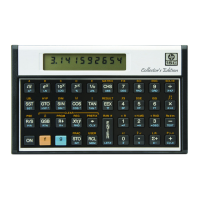174 Section 12: Calculating with Matrices
Conditional Tests on Matrix Descriptors
Four conditional tests—~, T 0 (x ≠ 0), T 5 (x = y), and
T 6 (x ≠ y)—can be performed with matrix descriptors in the X- and
Y-registers. Conditional tests can be used to control program execution,
as described in Section 8.
If a matrix descriptor is in the X-register, the result of ~ will be false
and the result of T 0 will be true (regardless of the element values
in the matrix.)
If matrix descriptors are in the X- and Y-registers when T 5 or T
6 conditional test is performed, x and y are equal if the same descriptor
is in the X- and Y-registers, and not equal otherwise. The comparison is
made between the descriptors themselves, not between the elements of
the specified matrices.
Other conditional tests can’t be used with matrix descriptors.
Stack Operation for Matrix Calculations
During matrix calculations, the contents of the stack registers shift much
like they do during numeric calculations.
For some matrix calculations, the result is stored in the result matrix. The
arguments—one or two descriptors or numbers in the X-register or the
X- and Y-registers—are combined by the operation, and the descriptor of
the result matrix is placed in the X-register. (The argument from the X-
register is placed in the LAST X register.)

